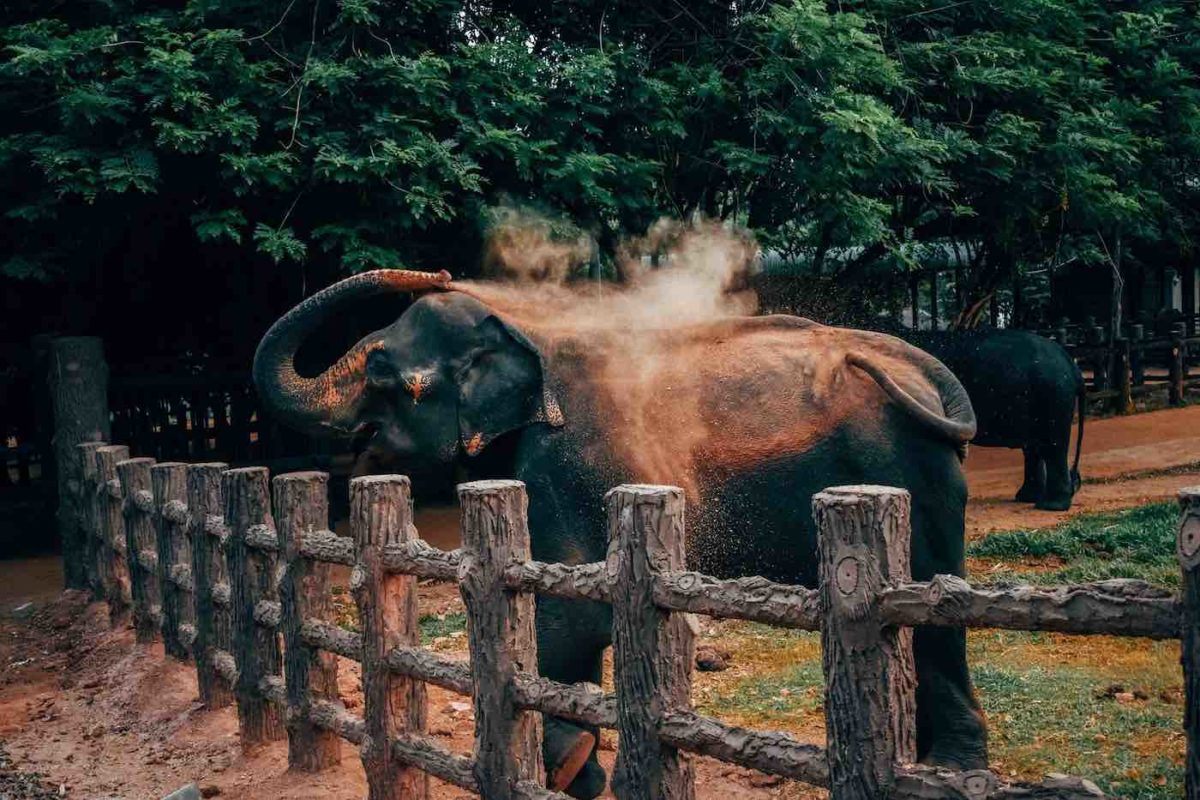There are some Elephants behaviors that can be said to be natural or stereotypical, but then there are some that are considered to be abnormal. The swaying of an Elephant is something that is often linked to distress, so if you see an Elephant swaying then it’s likely that something is wrong.
Other abnormal behaviors in Elephants include:
- Playing with objects that aren’t toys
- Obsessively chewing on things
- Self-mutilation
- Excessive shaking or twitching
- Aggression towards people or other animals
However, it has also been noted that some captive elephants sway due to an instinctual need to keep balance. Swaying can also be a sign of physical discomfort, such as when an elephant is experiencing joint pain.
Trunk-in-air behaviour is another sign of distress in elephants. This is when an elephant lifts its trunk up in the air and waves it around, often while making a trumpeting sound.
This behaviour is usually only seen when an elephant is severely distressed or agitated.
Stereotypic behaviors
Amongst wild elephants in their natural habitat it’s not uncommon to see certain behaviors that could be considered as ‘stereotypic’.
A stereotype is defined as a repetitive behavior that serves no real purpose other than the need to perform the action. These types of behaviors are often seen in captive animals who don’t have enough stimulation in their environment.
Some examples of stereotypic behaviors in elephants include:
- Pacing back and forth
- Rocking from side to side
- Swinging their trunk back and forth
- Tossing their head from side to side (also known as head bobbing)
These behaviors can be harmful to the elephant as they can lead to joint problems and muscle strains.
Differences in behaviors between Asian elephants and African elephants
The two main specifies of elephants are the Asian elephant and the African elephant (there’s also a third, you can read about the differences between these species here). Although they are very similar, there are some notable differences between them. One of these differences is in their behaviors.
Asian elephants are known to be more aggressive than African elephants. They are also more likely to attack humans, even if those humans haven’t done anything to provoke the attack.
African elephants, on the other hand, are more likely to flee when they feel that they or their family members are threatened.
Asian elephants also tend to be more independent than African elephants. They live in smaller groups and are less likely to follow the lead of a dominant individual. African elephants, on the other hand, live in large herds led by a matriarch.
When it comes to stereotypic behaviors, African elephants are more likely to engage in them than Asian elephants. This is likely because African elephants are more often kept in captivity than Asian elephants.
Some people believe that the difference in behavior between African and Asian elephants is due to their different diets. African elephants eat mostly grass, while Asian elephants eat mostly trees and shrubs.
It’s thought that the different nutrients in these two diets might impact the elephants’ behavior.
However, there is no scientific evidence to support this theory.
Natural behavior amongst Wild Elephants
Some of the more normal behaviors of Elephants include:
- Trumpeting
- Grazing
- Walking
- Dust bathing
- Playing in water
These are just a few examples, but as you can see there is quite a difference between the abnormal and normal behaviors of Elephants.

Captive Elephants and their behaviors
Most elephants in captivity will exhibit some abnormal behaviors due to the stresses of their environment, so it’s important to keep an eye out for these.
Elephants in confined spaces, such as zoos and circuses, often pace back and forth or sway due to the lack of space and the boredom they feel.
Trumpeting is a common behavior in captive elephants, but it can also be a sign of distress. If an elephant is trumpeting excessively then it’s likely that something is wrong.
Grazing is a natural behavior for elephants, but in captivity they are often not given enough food to graze on. This can lead to them chewing on objects such as bars or fences, which can be both harmful and lead to severe stress.
Walking is another natural behavior, but captive elephants often don’t have enough space to walk around. This can lead to them pacing back and forth or swaying.
Playing in water is a natural behavior for elephants, but in captivity, such as in a zoo they often don’t have enough space to do this.
This can lead to them swinging their trunk back and forth or tossing their head from side to side.
Elephants swaying and weaving
Some people believe that elephants swaying and weaving is a sign of distress, but this isn’t always the case. Elephants in the wild will often sway and weave when they are grazing on grasses.
This helps them to keep their balance and also allows them to reach the tallest blades of grass.
However, captive elephants (especially if they are older elephants) often don’t have enough food to graze on and so they will sway and weave due to the lack of nutrition. This can lead to joint problems and muscle strains.
Reading different types of swaying and weaving
It’s more common that female elephants will sway and weave than males, but this isn’t always the case. Females will often sway and weave when they are pregnant or when they have young calves. This is due to the extra weight they are carrying and also the need to keep their balance.
Males will often sway and weave when they are fighting or when they are trying to impress a female or other elephants. This is due to the need to keep their balance and also to look bigger and more impressive.
Elephants in musth that sway
Musth is a condition that affects male elephants and is characterized by a rise in testosterone levels.
This can lead to aggressive behaviors such as trumpeting, head-bobbing, charging, and swaying.
Do Elephants sway to music?
There is no scientific evidence to support this, but some people believe that elephants sway to music because it makes them feel good.
This is due to the fact that elephants have a very good sense of hearing and they might be able to pick up on the vibrations of the music.
Frequently Asked Questions (FAQ) about Abnormal behaviors in Elephants
If an elephant is trumpeting excessively, pacing back and forth, or swaying then it’s likely that something is wrong.
Yes, elephants can sway when they are stressed due to the lack of space and the boredom they feel.
This could be a sign that something is wrong and the elephant is trumpeting excessively.
There is no scientific evidence to support this, but some people believe that elephants sway to music because it makes them feel good.
Read about more Elephant behaviors
In Conclusion
Elephants swaying and weaving is a normal behavior that can be seen both in the wild and captivity. While some people believe that this is a sign of distress even in elephants in the wild, it’s more likely just an elephant trying to keep its balance.
However, amongst elephants in captivity often sway and weave due to the lack of space and nutrition. It’s important to be able to read the different types of swaying and weaving so that you can correctly interpret what the elephant is trying to communicate.
If you see an elephant that is swaying excessively or showing other signs of distress, then it’s important to contact a professional for help.

One reply on “Abnormal behaviors in Elephants; Swaying is normally linked to distress”
i love elephants soooo much and this is a really good website